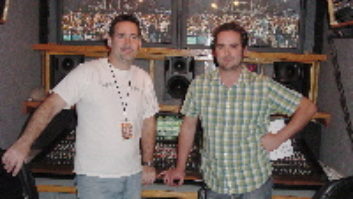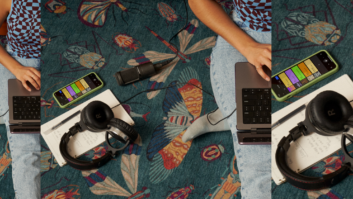When Maine Radio & Television subsidiary CSP Mobile Productions launched its first video truck in 1989, the company was building on a 60-year tradition as a pioneering broadcaster in the Portland market. The remote truck was an extension of Maine Radio & Television’s core business of creating and capturing programming for its TV and radio outlets. The location business grew to the point where a second truck was added to the fleet, and the client list expanded accordingly, ranging from sports giants ESPN, Major League Baseball and the National Basketball Association, to entertainment events such as the Country Music Awards’ “Backstage Pass” and concerts by Aerosmith, Brandy and Wynton Marsalis. Focused on the video broadcast side of the business, CSP specialized in delivering high-quality visuals to its clients, with the audio usually mixed live and seldom multitracked.
However, the rise of the DVD market suggested to CSP’s principals that many of the special events that the company covered — particularly music-based ones — might benefit from being recorded in a high-quality multitrack format and archived for future use. To that end, CSP president Nat Thompson commissioned a state-of-the-art audio truck that could compete with the industry’s remote recording elite — a close-knit group of competitive, passionate and fiercely independent owner/engineers. The result of Thompson’s vision was Unit 6, a single-body, 28-foot truck equipped with a 96-input Yamaha PM-1D digital console, six Tascam DA-78s, two Tascam MX-2424 hard disk recorders, surround monitoring via Genelec 1031s (with a 1092A subwoofer) and top-notch processing gear.
“The rise of the DVD market has certainly been one of the factors why we felt this truck would be able to sell itself,” Thompson says. “Being able to do the multitrack records is essential, because so often a band will come back after the fact and say, ‘Gee, could we do a remix on that show? We had a particularly good performance that night, the video’s looking really good and we’d like to make something of it.’ That kind of scenario had a lot to do with the whys and wherefores of this truck.”
Unit 6 could not have come at a better time for CSP. Since launching the vehicle in late 2000, it has been used for a wide range of events that have taken advantage of the truck’s live mixing, multitracking and surround capabilities. A Foo Fighters concert in Atlanta in October 2000 was a case in point — CSP was hired to do the event as a live, pay-per-view project, with video and audio broadcast live. “We were focused on capturing the show live and doing a great job that night, but we had the multitracks running,” says Lance Vardis, an independent engineer who does the lion’s share of his work for CSP. “The band had such a good time that night that they decided they wanted to potentially do a DVD release. We got the call to do a remix of the audio in surround, which we did in the truck. Everything fell right into place.”
That yet-to-be-released Foo Fighters project — which was authored and mastered nearby at Bob Ludwig’s Gateway Mastering and DVD studio in Portland — proved to be a turning point for CSP. “That was when we realized, ‘Wait a minute, these projects have a life after the initial event,’” says Vardis.
Another show that exploited the multitracking and mixing potential of Unit 6 was a concert recording by contemporary Christian music superstar Carman. The event was taped by CSP for broadcast on Easter Sunday, 2001, so Vardis captured the audio (80 tracks’ worth, bringing in additional gear to accommodate the extra material) onto the Tascam tape and hard disk units, rough-mixed the show live and then spent several days afterward working on the broadcast mix. “They had every intention of doing a home video release after the fact, so we had that in the back of our minds,” says Vardis. “They’re still debating whether they want to do a DVD, but in the meantime, we have the tapes filed away, so if they decide they want to do something, say, next holiday season, it’s always there.”
From an engineering standpoint, Vardis gets excited by the energy of live events, but he also appreciates the chance to go back and tweak his mixes. “Live events are great,” he says. “When they’re done, they’re done. You do the best job you can that night and it’s exciting. But, as every audio engineer knows, if you have a chance to do a remix, you take it. You think, ‘Hmm, that could have been a little better.’”
Recently, CSP drove Unit 6 and one of its video trucks (which are labeled Unit 4 and Unit 5) to New York for a Barenaked Ladies pay-per-view event. Although a planned multitracking component to that show fell through, the event still illustrated why CSP’s investment in an audio truck is paying off.
“The Barenaked Ladies show coincided nicely with the Audio Engineering Society Convention in New York,” observes Thompson. “That allowed us to park the truck at Roseland Ballroom for the show on Friday night, and then drive the truck a few blocks downtown to the Javits Center to exhibit it at the show.” On the second day of the AES show, CSP set up video and audio monitors outside Unit 6 so that passing convention attendees could catch a glimpse of the previous night’s Barenaked Ladies show.
Besides the day-to-day production projects that make up the bread-and-butter of CSP’s mobile recording business, Unit 6 is also destined to serve the company in another capacity: creating broadcast-ready programming in-house. Thompson says, “There are programming things we felt we might be able to generate internally, from the standpoint of being able to do a live-to-tape project, a multitrack record, a remix, a post-production job or whatever it might be, and take a full show to, say, HBO on the programming side of things and sell it that way. In the entertainment industry, that crossing over between music and visuals has become such a big thing. We’re in a perfect position to take advantage of it because we’ve been in the broadcast business for a long time, and now we’re concentrating on the mobile production business.”
As CSP’s projects move downstream, they — like so many music productions these days — end up in Digidesign Pro Tools workstations. Although CSP doesnot yet have its own Digidesign system, recording is to the Tascam MX-2424 in Sound Designer II format, ensuring full compatibility with Pro Tools users on the post-production side. And, with a TDIF digital audio connection between the MX-2424s and DA-78s, the tape machines serve as a real-time backup system, saving CSP the headache of archiving its hard disk data onto a third-party storage device.
The layout and design of Unit 6 were largely the work of CSP VP of technical operations and production Len Chase, who developed plans to build a dedicated audio truck in mid-1999. “Len approached me with the idea of building a state-of-the-art truck where we could do high-quality multitracking and surround,” says Vardis. “I took the equipment and acoustics side, and he took the mechanics and electric side of it. Initially, it was going to be three Yamaha 02Rs and Tascam DA-78s, but when we found out that Yamaha was introducing the PM-1D, we jumped at the chance to get it.”
Although CSP made a substantial investment in Unit 6 (approximately $500,000), the price tag was actually small by comparison to some of the company’s competitors. “We’re not trying to compete with the big Neve Capricorns and the Euphonixes and the SSLs out there,” says Thompson. “We found a board and a truck that work well together; it’s fairly simple from an engineering standpoint, and it interfaces with a video truck nicely. I’m very happy the way that’s worked, and everyone who’s seen it has been very happy, so I’m thrilled.”






